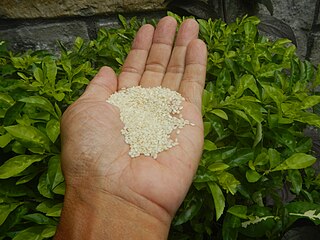Related Research Articles

Allergies, also known as allergic diseases, are various conditions caused by hypersensitivity of the immune system to typically harmless substances in the environment. These diseases include hay fever, food allergies, atopic dermatitis, allergic asthma, and anaphylaxis. Symptoms may include red eyes, an itchy rash, sneezing, coughing, a runny nose, shortness of breath, or swelling. Note that food intolerances and food poisoning are separate conditions.

Quackery, often synonymous with health fraud, is the promotion of fraudulent or ignorant medical practices. A quack is a "fraudulent or ignorant pretender to medical skill" or "a person who pretends, professionally or publicly, to have skill, knowledge, qualification or credentials they do not possess; a charlatan or snake oil salesman". The term quack is a clipped form of the archaic term quacksalver, from Dutch: kwakzalver a "hawker of salve". In the Middle Ages the term quack meant "shouting". The quacksalvers sold their wares at markets by shouting to gain attention.
A radioallergosorbent test (RAST) is a blood test using radioimmunoassay test to detect specific IgE antibodies in order to determine the substances a subject is allergic to. This is different from a skin allergy test, which determines allergy by the reaction of a person's skin to different substances.
Vega machines are a type of electroacupuncture device used in pseudoscientific Vega testing, which proponents claim can diagnose allergies and other illnesses. The forerunner to the Vega test was electroacupuncture according to Voll developed by Reinholdt Voll in the 1950s. Helmut Schimmel modified the technique in the 1970s and presented it under the name Vega test.

Stephen Joel Barrett is an American retired psychiatrist, author, co-founder of the National Council Against Health Fraud (NCAHF), and the webmaster of Quackwatch. He runs a number of websites dealing with quackery and health fraud. He focuses on consumer protection, medical ethics, and scientific skepticism.
Metabolic typing is a pseudoscience whose proponents believe that each person has a unique metabolism, and that the proportion of macromolecules which are optimal for one person may not be for a second, and could even be detrimental to them.
Orthomolecular psychiatry is the use of orthomolecular medicine for mental illness. The approach uses unorthodox forms of individualized testing and diagnosis to attempt to establish an etiology for each patient's specific symptoms, and claims to tailor the treatment accordingly, using a combination of nutrients, dietary changes and medications that are claimed to enhance quality of life and functionality as well as to reduce or eliminate symptoms and the use of xenobiotic drugs. Scientific studies have shown mixed results; although there are some promising results from nutritional psychiatry, some forms of orthomolecular psychiatry are ineffective.

Emily Rosa is the youngest person to have a research paper published in a peer reviewed medical journal. At age nine Rosa conceived and executed a scientific study of therapeutic touch which was published in the Journal of the American Medical Association in 1998. She graduated from the University of Colorado at Denver in 2009 with a major in psychology. Her parents, Larry Sarner and Linda Rosa, are leaders of the advocacy group Advocates for Children in Therapy.

Applied kinesiology (AK) is a pseudoscience-based technique in alternative medicine claimed to be able to diagnose illness or choose treatment by testing muscles for strength and weakness.
Nambudripad's Allergy Elimination Techniques (NAET) is a form of alternative medicine which proponents claim can treat allergies and related disorders. The techniques were devised by Devi Nambudripad, a California-based chiropractor and acupuncturist, in 1983, drawing on a combination of ideas from applied kinesiology, acupuncture, acupressure, nutritional management, and chiropractic methods.
Live blood analysis (LBA), live cell analysis, Hemaview or nutritional blood analysis is the use of high-resolution dark field microscopy to observe live blood cells. Live blood analysis is promoted by some alternative medicine practitioners, who assert that it can diagnose a range of diseases. There is no scientific evidence that live blood analysis is reliable or effective, and it has been described as a fraudulent means of convincing people that they are ill and should purchase dietary supplements.
In mainstream scientific usage, hair analysis is the chemical analysis of a hair sample. The use of hair analysis in alternative medicine as a method of investigation to assist alternative diagnosis is controversial and its use in this manner has been opposed repeatedly by the AMA because of its unproven status and its potential for healthcare fraud.

Radionics—also called electromagnetic therapy (EMT) and the Abrams Method—is a form of alternative medicine that claims that disease can be diagnosed and treated by applying electromagnetic radiation (EMR), such as radio waves, to the body from an electrically powered device. It is similar to magnet therapy, which also applies EMR to the body but uses a magnet that generates a static electromagnetic field.

Lendon Howard Smith was an American Ob/Gyn, pediatrician, author, and television personality. He was notable for his advice on parenting and advocating children's health and eating issues. He was known to fans as "The Children's Doctor" for his expertise on the issues and an outspoken proponent of the use of vitamins for children.
Doctor's Data, Inc. is a clinical laboratory based in St. Charles, Illinois that is often used by practitioners of alternative medicine.
William Shaw is an American chemist and the founder of the Great Plains Laboratory, based in Lenexa, Kansas. Great Plains Laboratory is listed as "performing nonstandard laboratory tests" by Quackwatch.
Chronic Lyme disease (CLD) is the name used by some people with "a broad array of illnesses or symptom complexes for which there is no reproducible or convincing scientific evidence of any relationship to Borrelia burgdorferi infection" to describe their condition and their beliefs about its cause. Both the label and the belief that these people's symptoms are caused by this particular infection are generally rejected by medical professionals. Some doctors view the promotion of chronic Lyme disease as an example of health fraud. Chronic Lyme disease is distinct from genuine Lyme disease, a known medical disorder caused by infection with Borrelia burgdorferi, or with post-treatment Lyme disease syndrome, a set of lingering symptoms which may persist after successful treatment of infection with Lyme bacteria.
Candida hypersensitivity is a pseudoscientific syndrome promoted by William G. Crook, M.D. It is spuriously claimed that chronic yeast infections are responsible for many common disorders and non-specific symptoms including fatigue, weight gain, constipation, dizziness, muscle and joint pain, asthma, and others.

A food allergy to sesame seeds has prevalence estimates in the range of 0.1–0.2% of the general population, and are higher in the Middle East and other countries where sesame seeds are used in traditional foods. Reporting of sesame seed allergy has increased in the 21st century, either due to a true increase from exposure to more sesame foods or due to an increase in awareness. Increasing sesame allergy rates have induced more countries to regulate food labels to identify sesame ingredients in products and the potential for allergy. In the United States, sesame became the ninth food allergen with mandatory labeling, effective 1 January 2023.
References
- ↑ Barrett, Stephen (6 May 2018). "Dubious diagnostic tests". QuackWatch . Retrieved 5 July 2018.
- ↑ Bernstein IL, Li JT, Bernstein DI, Hamilton R, Spector SL, Tan R, et al. (2008). "Allergy diagnostic testing: an updated practice parameter". Ann Allergy Asthma Immunol. 100 (3 Suppl 3): S1-148. doi:10.1016/S1081-1206(10)60305-5. PMID 18431959.
- ↑ Medical Practitioners Disciplinary Tribunal of New Zealand findings in re Richard Gorringe and the PMRT/Bi-Digital O-Ring Test
- ↑ "ASA Adjudication on Medical Thermal Imaging Ltd". Advertising Standards Authority. 2013-01-09. Retrieved January 5, 2015.
- ↑ Barrett, Stephen (12 July 2009). "Some Notes on the Quantum Xrroid (QXCI) and William C. Nelson". Quackwatch . Retrieved 2007-02-12.
- ↑ Barrett, Stephen (14 February 2018). "Quack "Electrodiagnostic" Devices". Quackwatch. Retrieved 8 September 2022.
- 1 2 "Alternative Food Allergy Tests to Avoid". Kids with Food Allergies. Asthma and Allergy Foundation of America. Retrieved 8 September 2022.
- ↑ Barrett, Stephen; Hall, Harriet (24 November 2008). "Dubious Genetic Testing" . Retrieved 5 July 2018.
- ↑ Seidel, S. (2001). "Assessment of Commercial Laboratories Performing Hair Mineral Analysis". JAMA: The Journal of the American Medical Association. 285 (1): 67–72. doi:10.1001/jama.285.1.67. PMID 11150111.
- ↑ "Hair Analysis: What Can Your Hair Tell About You?".
- ↑ "The Myth of IgG Food Panel Testing". American Academy of Allergy, Asthma & Immunology. Retrieved 8 September 2022.
- ↑ "CLIA regulation of unestablished laboratory tests" (PDF). U.S. Department of Health and Human Services. July 2001. Archived from the original (PDF) on April 28, 2017. Retrieved January 26, 2009.
- ↑ Barrett, Stephen (10 June 2017). "How the "Urine Toxic Metals" Test Is Used to Defraud Patients". QuackWatch . Retrieved 5 July 2018.
- ↑ Daley, Beth (17 June 2014). "Can you trust Lyme Disease tests?". WGBH. Retrieved 9 September 2022.
- ↑ Kawamoto, M; Page, E (20 February 2015). "Notes from the field: Use of unvalidated urine mycotoxin tests for the clinical diagnosis of illness--United States, 2014". MMWR. Morbidity and Mortality Weekly Report. 64 (6): 157–8. PMC 4584707 . PMID 25695323.